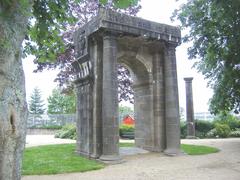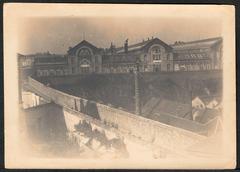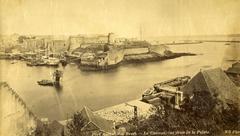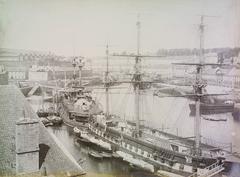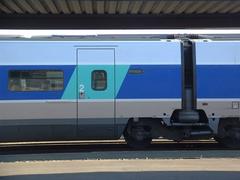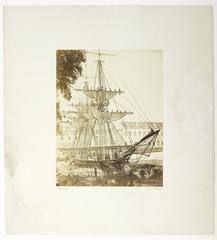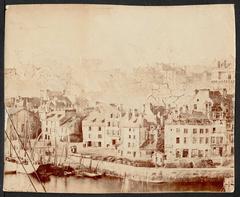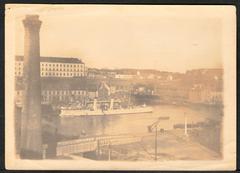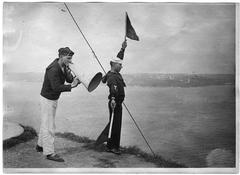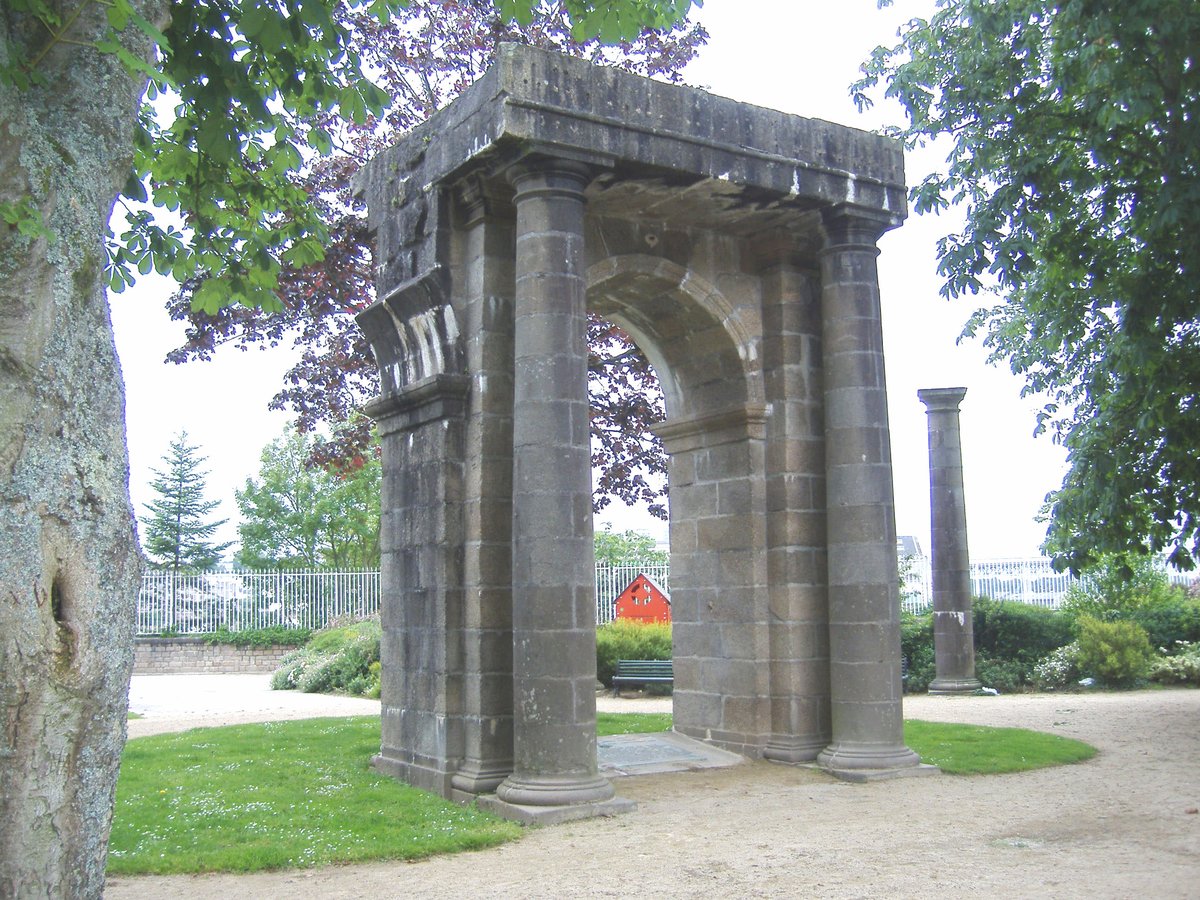
Visiting the Péristyle de la Caserne Fautras, Brest, France: Complete Guide, Practical Info, and Historical Context
Date: 14/06/2025
Introduction
Located in the heart of Brest, France, the Péristyle de la Caserne Fautras is a remarkable vestige of the city’s military and architectural history. As one of the few surviving elements from the original Caserne Fautras—a vast military barracks complex destroyed during World War II—the Péristyle stands as a symbol of Brest’s resilience, heritage, and ongoing commitment to remembrance. Today, this neoclassical portico, set in a tranquil urban park, offers visitors a rare physical connection to Brest’s 19th-century past and an entry point for exploring the city’s broader maritime and military legacy.
This guide provides a detailed overview of the Péristyle’s origins, architectural significance, practical information for visiting, and tips for making the most of your exploration in Brest. Whether you are a history enthusiast, a casual traveler, or a local seeking to reconnect with your city’s roots, this resource will help you experience the enduring legacy of the Caserne Fautras.
Table of Contents
- Historical Background and Origins
- Architectural Features and Significance
- Wartime Destruction and Preservation
- Visiting the Péristyle: Practical Information
- Nearby Attractions and Suggested Itineraries
- Digital Resources and Further Learning
- Frequently Asked Questions (FAQ)
- Visitor Tips and Etiquette
- Conclusion and Recommendations
- Sources and Further Reading
Historical Background and Origins
The Caserne Fautras: Brest’s Military Stronghold
The Caserne Fautras was a cornerstone of Brest’s military and urban infrastructure from the mid-18th century through the early 20th century. Its construction began in 1730, with significant phases completed between 1741 and 1744, and later expansions in the 19th century. Designed to accommodate the needs of the French Navy and later colonial regiments, the barracks played a key role in Brest’s defense and the city’s status as a vital naval port (Wiki-Brest; POP: Plateforme ouverte du patrimoine).
The caserne was named in honor of Chevalier André de Fautras d’Andreuil in 1785, recognizing his contributions to the French marine troops (1er RAMA). Over the decades, the barracks housed several notable regiments, including the 1st Regiment of Marine Artillery and the 2nd Regiment of Colonial Infantry, further cementing its importance in French military and colonial endeavors (Amicale 2RIMA).
Architectural Features and Significance
The Péristyle: Neoclassical Design and Functional Heritage
The Péristyle was the ceremonial and architectural centerpiece of the Caserne Fautras. Designed in 1819 by engineer Jean-Nicolas Trouille, it features a classical portico with three arches supported by six robust stone columns. The use of local stone, symmetrical design, and integration with the urban landscape reflect both the functional requirements and aesthetic ideals of early 19th-century French military architecture (Wiki-Brest; KilroyTrip).
Above the central pavilion, an observatory was added in 1820, designed by Borda, rising 109 meters above sea level and serving as a strategic lookout. The entire Caserne Fautras complex once stretched approximately 250 meters, with the Péristyle acting as a symbolic gateway for generations of soldiers and a focal point for military ceremonies (KilroyTrip).
Wartime Destruction and Preservation
World War II and the Loss of the Barracks
In 1944, intense Allied bombardments targeting German-occupied facilities resulted in the near-total destruction of the Caserne Fautras, mirroring the fate of much of Brest at the time (Angelique Berhault; France-Voyage). Only the Péristyle survived, albeit badly damaged.
Recognizing its symbolic importance, local veterans, historians, and civic leaders advocated for its preservation. After partial restoration, the Péristyle was re-inaugurated in 1963 on Boulevard Jean Moulin, standing as a tangible link to Brest’s pre-war cityscape and a testament to the community’s dedication to heritage preservation (Amicale 2RIMA).
Visiting the Péristyle: Practical Information
Location and Setting
The Péristyle de la Caserne Fautras is situated within a small, landscaped triangular park near a roundabout on Boulevard Jean Moulin, close to the Brest cable car terminal and major city arteries (Visorando). The site is a peaceful green space, ideal for reflection or a quiet break during your exploration of Brest’s urban center.
Hours and Accessibility
- Visiting Hours: The Péristyle is in a public park open 24/7, year-round.
- Tickets and Fees: Admission is free; no tickets are required.
- Accessibility: The monument is accessible on foot and by public transport. The park is suitable for visitors with limited mobility, though surrounding streets may be uneven due to the city’s hilly terrain.
Getting There
- On Foot: Easily reachable from central Brest, especially if you’re visiting the Ateliers des Capucins or Rue de Siam.
- Public Transport: Well-served by Brest’s bus, tram, and cable car networks.
- By Car: Parking is available nearby, particularly at Parc à Chaînes.
Facilities
There are no dedicated visitor facilities at the Péristyle itself. However, cafés, shops, and public restrooms are available within a short walk, especially in the Ateliers des Capucins and along Rue de Siam.
Nearby Attractions and Suggested Itineraries
Enhance your visit to the Péristyle by exploring these nearby sites:
- Ateliers des Capucins: A former naval workshop now transformed into a vibrant cultural center with exhibitions, a library, and cafés.
- Brest Cable Car: Offers scenic transport and unique views over the Penfeld and Brest’s harbor area.
- Jardin des Explorateurs: Botanical gardens with panoramic vistas over the Rade de Brest.
- Château de Brest and Musée National de la Marine: The city’s medieval castle, home to the National Maritime Museum, further contextualizes Brest’s naval legacy (France-Voyage).
Digital Resources and Further Learning
For those interested in deeper historical context or unable to visit in person, several digital resources provide detailed insights:
- Archival Photographs and 3D Reconstructions: The Fautrasz Blog offers historical research, rare imagery, and virtual reconstructions of the original barracks.
- Official Heritage Platforms: The POP: Plateforme ouverte du patrimoine database includes detailed records and architectural analyses.
- Walking Tours and Itineraries: Self-guided routes incorporating the Péristyle are available online (Visorando).
Frequently Asked Questions (FAQ)
Q: What are the visiting hours of the Péristyle?
A: The monument is in a public park open 24 hours a day, year-round.
Q: Is there an entrance fee or ticket required?
A: No, access is free and unticketed.
Q: Are guided tours available?
A: There are no regular guided tours specifically for the Péristyle, but it is featured in several self-guided and organized historical walks.
Q: Is the site accessible for people with reduced mobility?
A: The monument is accessible, though some surrounding streets are uneven due to Brest’s topography.
Q: Are there restrooms or cafés at the site?
A: No, but amenities are available nearby, especially within the Ateliers des Capucins.
Q: Can I take photos at the Péristyle?
A: Absolutely—photography is encouraged.
Visitor Tips and Etiquette
- Respect the Site: As a place of memory and a public park, please be considerate of other visitors and the monument’s historical significance.
- Photography: Best times for photos are early morning or late afternoon for optimal light.
- Quiet Reflection: The Péristyle is ideal for contemplation—take a moment to reflect on Brest’s history.
Conclusion and Recommendations
The Péristyle de la Caserne Fautras is more than an architectural relic; it is a powerful symbol of Brest’s resilience, military history, and community spirit. Its survival and restoration offer a window into the city’s 19th-century heritage while serving as a reminder of the devastation and renewal that shaped modern Brest. Whether you are exploring the city’s historical circuits, seeking a tranquil break, or interested in the layers of urban memory, the Péristyle is an essential stop.
For a richer experience, combine your visit with nearby sites like the Ateliers des Capucins and the Château de Brest, and utilize digital resources to delve deeper into the story of the Caserne Fautras. Stay informed about events and new heritage initiatives by downloading the Audiala app and following local tourism channels.
Sources and Further Reading
- Caserne Fautras Brest, 2025, Wiki-Brest (http://www.wiki-brest.net/index.php/Caserne_Fautras_Brest)
- Caserne Fautras Memorial, 2025, KilroyTrip (https://www.kilroytrip.fr/memoriaux/caserne-fautras)
- Exploring Caserne Fautras, 2025, Fautrasz Hypotheses Blog (https://fautrasz.hypotheses.org/caserne-fautras)
- Brest History of a Monument, 2025, Amicale 2RIMA (http://amicale2rima.fr/index.php/traditions/histoire-tdm/8-histoire-tdm-/1127-brest-histoire-dun-monument)
- Caserne Fautras Heritage, 2025, POP: Plateforme ouverte du patrimoine (https://pop.culture.gouv.fr/notice/merimee/IA29004656)
- Brest Tourism Overview, 2025, France-Voyage (https://www.france-voyage.com/tourism/brest-348.htm)
